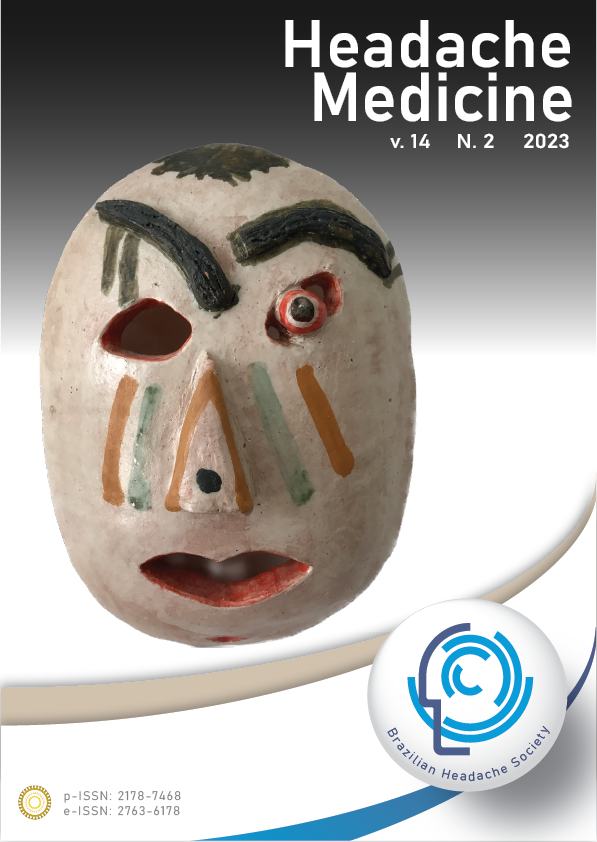Avaliação do uso de anticorpos monoclonais (mAbs) CGRP na profilaxia da enxaqueca em uma clínica privada
Views: 400DOI:
https://doi.org/10.48208/HeadacheMed.2023.17Palavras-chave:
Peptídeo relacionado ao gene da calcitonina, Migrânea, Profilaxia, Tratamento, Anticorpos monoclonais CGRPResumo
Introdução
A enxaqueca é considerada o segundo distúrbio neurológico mais prevalente na população e altamente incapacitante.
Objetivo
O objetivo deste estudo é avaliar o uso de anticorpos monoclonais do peptídeo relacionado ao gene da calcitonina (CGRP) na profilaxia da enxaqueca, com ênfase na resposta terapêutica, efeitos adversos e impactos na qualidade de vida.
Método
Foi realizado um estudo quantitativo, retrospectivo e descritivo, por meio da análise de prontuários e entrevistas telefônicas com pacientes atendidos no Serviço de Neurologia e Neurocirurgia, na cidade de Passo Fundo, RGS, Brasil, que já utilizaram ou utilizaram pelo menos uma dose do medicamento.
Conclusão
Assim, entende-se que os anticorpos monoclonais CGRP são capazes de reduzir os dias mensais de cefaléia, reduzir a intensidade da dor e promover melhora na capacidade laboral. Portanto, podem ser considerados medicamentos eficazes, seguros e de boa adesão na profilaxia da enxaqueca.
Downloads
Referências
Lombard L, Farrar M, Ye W, Kim Y, Cotton S, Buchanan AS, . . . Joshi S. A global real-world assessment of the impact on health-related quality of life and work productivity of migraine in patients with insufficient versus good response to triptan medication. The Journal of Headache and Pain 2020; 21(1): Doi:10.1186/s10194-020-01110-9 DOI: https://doi.org/10.1186/s10194-020-01110-9
Ho TW, Edvinsson L and Goadsby PJ. CGRP and its receptors provide new insights into migraine pathophysiology. Nature Reviews Neurology 2010; 6(10): 573-582 Doi:10.1038/nrneurol.2010.127 DOI: https://doi.org/10.1038/nrneurol.2010.127
Olesen J. Preface to the Second Edition. Cephalalgia 2016; 24(1_suppl): 9-10 Doi:10.1111/j.1468-2982.2003.00824.x DOI: https://doi.org/10.1111/j.1468-2982.2003.00824.x
Ashina M, Saper J, Cady R, Schaeffler BA, Biondi DM, Hirman J, . . . Smith J. Eptinezumab in episodic migraine: A randomized, double-blind, placebo-controlled study (PROMISE-1). Cephalalgia 2020; 40(3): 241-254 Doi:10.1177/0333102420905132 DOI: https://doi.org/10.1177/0333102420905132
Martelletti P, Schwedt TJ, Lanteri-Minet M, Quintana R, Carboni V, Diener H-C, . . . Vo P. My Migraine Voice survey: a global study of disease burden among individuals with migraine for whom preventive treatments have failed. The Journal of Headache and Pain 2018; 19(1): Doi:10.1186/s10194-018-0946-z DOI: https://doi.org/10.1186/s10194-018-0946-z
Goadsby PJ, Holland PR, Martins-Oliveira M, Hoffmann J, Schankin C and Akerman S. Pathophysiology of Migraine: A Disorder of Sensory Processing. Physiological Reviews 2017; 97(2): 553-622 Doi:10.1152/physrev.00034.2015 DOI: https://doi.org/10.1152/physrev.00034.2015
Dodick DW. A Phase-by-Phase Review of Migraine Pathophysiology. Headache: The Journal of Head and Face Pain 2018; 58(4-16 Doi:10.1111/head.13300 DOI: https://doi.org/10.1111/head.13300
Lipton RB, Stewart WF, Diamond S, Diamond ML and Reed M. Prevalence and Burden of Migraine in the United States: Data From the American Migraine Study II. Headache: The Journal of Head and Face Pain 2001; 41(7): 646-657 Doi:10.1046/j.1526-4610.2001.041007646.x DOI: https://doi.org/10.1046/j.1526-4610.2001.041007646.x
Raffaelli B, Neeb L and Reuter U. Monoclonal antibodies for the prevention of migraine. Expert Opinion on Biological Therapy 2019; 19(12): 1307-1317 Doi:10.1080/14712598.2019.1671350 DOI: https://doi.org/10.1080/14712598.2019.1671350
Loder EW and Rizzoli P. Tolerance and Loss of Beneficial Effect During Migraine Prophylaxis: Clinical Considerations. Headache: The Journal of Head and Face Pain 2011; 51(8): 1336-1345 Doi:10.1111/j.1526-4610.2011.01986.x DOI: https://doi.org/10.1111/j.1526-4610.2011.01986.x
Lipton RB, Munjal S, Buse DC, Alam A, Fanning KM, Reed ML, . . . Dodick DW. Unmet Acute Treatment Needs From the 2017 Migraine in America Symptoms and Treatment Study. Headache: The Journal of Head and Face Pain 2019; 59(8): 1310-1323 Doi:10.1111/head.13588 DOI: https://doi.org/10.1111/head.13588
Tepper SJ. History and Review of anti-Calcitonin Gene-Related Peptide (CGRP) Therapies: From Translational Research to Treatment. Headache: The Journal of Head and Face Pain 2018; 58(238-275 Doi:10.1111/head.13379 DOI: https://doi.org/10.1111/head.13379
Henson B, Hollingsworth H, Nevois E and Herndon C. Calcitonin Gene-Related Peptide (CGRP) Antagonists and Their Use in Migraines. Journal of Pain & Palliative Care Pharmacotherapy 2019; 34(1): 22-31 Doi:10.1080/15360288.2019.1690616 DOI: https://doi.org/10.1080/15360288.2019.1690616
Downloads
- PDF (English) 216
Publicado
Como Citar
Edição
Seção
Licença
Copyright (c) 2023 Natalia Farenzena, Alan Christmann Fröhlich (Author)

Este trabalho está licenciado sob uma licença Creative Commons Attribution 4.0 International License.










